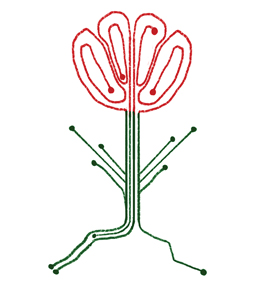The Next Big Thing
Introducing eight promising young startups — poised to make a splash and make a difference — built by inventive Brandeisians.

Annelise Capossela
by Lawrence Goodman
Sometimes it strikes while they’re still in college. Alan Ringvald ’04 started College Bellhop, an online errand service, in his dorm room.
Sometimes it takes root in a lab. Biology professor Larry Wangh ’68 began working on a new method for analyzing DNA 20 years ago.
Or sometimes it’s born after they have left Brandeis. David Klein ’02 created the student loan company CommonBond a decade after graduating.
Whenever the entrepreneurial spirit arises in Brandeis students and faculty, it often leads to something big: companies that promise to both reap significant financial rewards and transform society.
In 1997, associate professor of molecular biology Neil Simister, financial manager Laurence Blumberg ’83 and two other colleagues founded Syntonix Pharmaceuticals, the outgrowth of work they’d done on a cellular receptor protein called FcRn. The company’s research and product development eventually led to Alprolix and Eloctate, groundbreaking hemophilia drugs approved by the U.S. Food and Drug Administration in 2014. In addition to all the patients they have helped, Alprolix and Eloctate have generated millions of dollars in revenue for the university.
Research by professor emeritus of biology K.C. Hayes and biophysicist Daniel Perlman resulted in the “healthy fats” used in Smart Balance spread. Adam Cheyer ’88 co-founded the company Siri, which developed the digital personal assistant now on hundreds of millions of iPhones around the world.
Today, there’s a new crop of startups out there, some still in their infancy, others marketing products and making profits. Though known for their commitment to social justice and altruism, Brandeisians exhibit no shortage of business daring or acumen. “Brandeis supports a culture of exploration,” says Rebecca Menapace, associate provost for innovation. “It’s a very good environment for nurturing the entrepreneur. Students and faculty are allowed to pursue whatever their desires are.”
Here are some of their most creative and potentially lucrative ventures, which could very well make your life better — soon.

Annelise Capossela
Cardiac arrest has subtle warning signs that can tip off medical personnel to the impending emergency.
page 2 of 9
Quant HC
Dana Edelson ’96 saw it time and time again while working as a physician in a Chicago hospital in the 2000s. A patient would go into cardiac arrest, a code blue alert would sound, and staff would rush in to resuscitate. But despite their best efforts, the patient would die.
As Edelson did more research, she realized cardiac arrest had subtle warning signs that could tip off doctors and nurses to the impending emergency. “These events we were treating as sudden weren’t so sudden after all,” she says.
A self-professed data geek who trained as a hospitalist, Edelson went to work, developing an algorithm that could assess a hospitalized patient’s risk for cardiac arrest. She and her colleagues employed advanced statistics on millions of data points collected from hundreds of thousands of patients across five different hospitals to identify the telltale warning signs.
The result was eCART, short for electronic cardiac arrest risk triage, which analyzes more than 30 health criteria — everything from a patient’s respiratory rate to kidney function — and calculates the probability of cardiac arrest, ICU transfer or death. Edelson’s employer, University of Chicago Medicine, implemented eCART in 2015, a year after Edelson started Quant HC to commercialize the system.
Without Quant HC, Edelson says — if she had merely written papers and grant proposals — it would have taken 10 years for eCART to make its way into clinical practice. There are 200,000 in-hospital cardiac arrests every year, with a mortality rate of 80 percent. “To wait a decade was too painful to me,” she says. “We’d be letting people die when we knew how to help them.”
The transition from being a doctor to a CEO has been a challenge, Edelson admits. Successful CEOs have to take chances, but, “as a physician, I am incredibly risk averse,” she says. “This is the first time in my life that I have ever done anything I could truly fail at. I’ve had to fight my demons.”
Competitive advantage: Thirteen hospitals currently use eCART.
page 3 of 9
Werk
When her son was born five years ago, Anna Auerbach ’05 faced a common dilemma: She and her husband both worked full time. “Trying to balance life and work was really, really difficult,” she says.
Once she realized how many other mothers were in the same position, she says she decided to “devise a solution to get at the root of the problem, not just treat the symptoms.”
In 2016, Auerbach and business partner Annie Dean founded the New York-based startup Werk to promote greater flexibility in the workplace — everything from giving employees the option of working remotely to variable hours. Flexibility is especially vital for women, who, unable to achieve a work-life balance, often bow out from high-paying jobs or leave the workplace entirely.
Studies have shown that both male and female employees have better morale and higher productivity when they have more flexibility options. Employers who offer these options find it easier to attract the best talent.
Werk has developed a methodology for helping companies assess the need and desire for flexibility among employees. The consulting firm then suggests policies to implement. It has also developed a training program for human resources executives and others, and runs a job board that helps employees looking for flexible workplaces search for opportunities.
Auerbach’s family came to this country when she was 6 as part of an effort that helped Jews leave the Soviet Union. “Others were invested in creating opportunities for my family,” says the Harvard Business School grad and former McKinsey & Company consultant. “I’ve always felt I wanted to invest in creating opportunities for others.”
In five to 10 years, Auerbach hopes most companies will offer some form of flexibility to all employees. “Everyone should be working in a flexible way,” she says. “There shouldn’t be any human being in a job that’s inflexible.”
Competitive advantage: Raised $4 million. Featured in The New York Times and Fast Company, and on CNBC. Inc. magazine named Auerbach one of “15 Female Entrepreneurs to Watch Out For in 2017.” Former top State Department official and Princeton scholar Anne-Marie Slaughter is an adviser.
page 4 of 9
Relational Coordination Analytics
In the 1990s, while writing her business school dissertation, Jody Hoffer Gittell, professor of management at the Heller School for Social Policy and Management, studied the operations of Southwest, American, United and Continental airlines. Gittell was particularly impressed with Southwest, whose employees, she found, had a stronger sense of shared goals, a clearer understanding of one another’s work and higher levels of mutual respect.
From her research into the work culture and successful management practices at the airlines, she derived the concept of “relational coordination,” or RC. RC lays out a set of principles and practices that help a company thrive and get the best out of its workers. It stresses collaboration and cooperation among employees, the removal of barriers between departments, the unification of workers and their bosses around shared objectives, an overarching mission and continual improvement.
In 2013, Gittell and Saleema Moore, PhD’13, founded Relational Coordination Analytics (RCA). The company uses a scientific method developed by Gittell for assessing a business’ adherence to RC tenets. RCA also helps companies identify strengths and opportunities, and make necessary changes to improve employee engagement and worker performance.
Brandeis owns a 5 percent equity stake in the company. To date, RC Analytics has worked with upward of 100 firms around the world. Gittell’s research has established RC as a proven method for making improvements in the fields of health care and education.
Gittell says too many companies are organized according to an outdated model. Employees focus on pleasing their boss rather than collaborating with co-workers to achieve a common goal. They look up to an authority figure rather than across to colleagues. “We’ve inherited organizations that were basically designed for vertical communication rather than horizontal,” she says. “Bureaucracy used to be seen as the best way to organize.”
Competitive advantage: Backed by academic expertise. Extensive scholarship showing success. Based on research into the legendary success of Southwest Airlines — the perfect combination of high employee morale and big profits.

Annelise Capossela
CommonBond uses a proprietary algorithm to determine the best borrowing options for each customer.
page 5 of 9
CommonBond
Shortly after he got into business school, David Klein ’02 began applying for student loans. The process was arduous — mounds of paperwork, confusing questions on forms, poor customer service.
This was the inspiration for CommonBond, Klein’s New York-based finance company, which aims to make the entire student-loan application and refinancing process easier and offer low interest rates.
Since its founding in 2012, CommonBond has issued more than $2 billion in loan funding to students. The company says customers save an average of $24,000 over the course of their loan. And for every loan CommonBond makes, it funds the education of a child in the developing world through the nonprofit Pencils of Promise.
The federal government handles more than 90 percent of student loans in the U.S. Interest is generally fixed at a single rate regardless of a borrower’s past credit or future career earnings. According to Klein, his company has an edge because it can adjust interest rates on the basis of an applicant’s credit score and financial history, using a proprietary algorithm to determine the best options for each borrower.
Klein, who previously worked at McKinsey & Company and American Express, has ambitious plans. He wants to build on the relationship CommonBond forms with its student customers and offer them other financial services, such as mortgages, credit cards and equity management.
Competitive advantage: Raised $130 million in equity. Acquired the startup Gradible, which helps people pay off their student loans. Investors include ex-Citigroup CEO Vikram Pandit and former Thomson Reuters CEO Tom Glocer. This year, Fast Company named CommonBond one of the “World’s Most Innovative Companies.”
page 6 of 9
TwinStrand Biosciences
Scaling a vertical sheet of ice while climbing in Canada seven years ago, Jesse Salk ’04 came up with an idea for transforming cancer treatment. It seemed so simple he assumed it had either been done or could never work. “I spent a long time trying to figure out what was wrong with it,” he says, “but I couldn’t.”
Satisfied he was really onto something, Salk founded TwinStrand Biosciences in Seattle to commercialize his brainstorm. The 2-year-old company, which has grown rapidly, now has 14 employees.
TwinStrand’s technology, called Duplex Sequencing, identifies genetic mutations with a precision that the company says is 100,000 times more accurate than other tools on the market. Salk says it may soon be used for early detection of ovarian cancer, which kills 14,000 Americans every year but if caught soon enough is highly treatable.
It could also be used to determine if someone’s cancer is truly cured. Right now, lingering cancer cells can hide among millions of healthy ones. They possess minute errors in their genetic coding, which can make them nearly impossible to detect. Salk believes Duplex Sequencing is powerful enough to find them. “It’s capable of finding a very rare needle in a genetic haystack,” he says.
Salk’s idea is based on the approach our cells use to find and fix errors in our genetic code. Scientists have long known about this process; that’s why he figured someone must already have tried to use it for cancer diagnosis.
Attending Brandeis on a Justice Brandeis Scholarship, Salk studied with biology professor Larry Wangh, who was working to spin off his own research into a business. Wangh taught him about filing patents and working with investors.
“The lab did basic science, but there was always an emphasis on making something that would have a global impact beyond academia,” Salk says.
Salk has some big shoes to fill. His grandfather was Jonas Salk, the American physician who developed the first vaccine for polio, one of the most important medical breakthroughs of the 20th century. “That sets the bar pretty high,” Jesse says.
Competitive advantage: Three cancer diagnostic products in late-stage development; $10 million in funding; and research partnerships with Harvard, the National Institutes of Health and the Fred Hutchinson Cancer Research Center. Unbeatable lineage.

Annelise Capossela
Buying groups of brownfields spreads out the financial risk.
page 7 of 9
Cleanfield Capital
Want to buy a brownfield, a plot of land seeping with toxic chemicals? According to Brandeis International Business School faculty members Debarshi Nandy and Stephen Cecchetti, you shouldn’t stop at one. The best bet would be to buy 10.
Nandy, Cecchetti and former IBS senior administrative dean Kate Salop have formed Cleanfield Capital to purchase and facilitate the redevelopment of brownfields. They believe investors have lost money on brownfields in the past because it’s so difficult to anticipate a brownfield’s cleanup costs. In some cases, pollution turns out to be far worse than originally thought, and projects are abandoned.
Cleanfield Capital’s models suggest buying groups of brownfields, spreading out the financial risk. Although some cleanup sites will yield losses, others will be so successful the company will turn a profit overall. “It’s very similar to what venture capitalists do,” says Nandy — most of their investments might tank, but one may turn out to be the next Amazon.
Nandy, an associate professor of finance, says that once brownfields are cleaned, they have many possible uses. They can be converted into fields where solar panels are installed, which may require minimal cleanup. Or, they can be turned into commercial or residential developments, a process likely to require substantial remediation.
Cleanfield Capital is still in the early stages of development. Nandy and Cecchetti, the Rosen Family Chair in International Finance, are working on the financial formulas and algorithms to identify groupings of brownfields most likely to become profitable.
Competitive advantage: No shortage of opportunities — the federal government estimates there are 500,000 brownfield sites in urban, suburban and rural areas of the United States.

Annelise Capossela
A.I. Capital may have found a way to eliminate human error from investing.
page 8 of 9
A.I. Capital Management
How’s this for ambition: A.I. Capital Management wants to become one of the first hedge funds in the world fully managed by artificial intelligence. Its founder, Marshall Chang ’16, MA’17, believes he’s found a way to eliminate human error from the investing process.
Chang got interested in trading during his first year at Brandeis, when he dabbled in the foreign exchange market. He invested a few thousand dollars but within a few years had lost it all. He felt his emotions were getting in the way of making sound decisions.
So Chang taught himself computer programming, focusing on the algorithms used in Google’s AlphaGo project. In 2016, AlphaGo triumphed over one of the world’s best players of Go, an ancient game with an estimated 10,172 possible board positions.
“If it can succeed at Go, we can probably have some productive results with trading,” says Chang.
He says tests of his approach on foreign exchange markets have so far resulted in profits. “We are at a place where we’re confident about this technology,” he reports.
Experts have begun to recognize A.I. Capital’s potential. In May, the company was selected to participate in the competitive MassChallenge Boston, at which startups compete for financial support and training. The company has also been recognized by Brandeis with a SPARK grant and was chosen to become part of the National Science Foundation’s Brandeis I-Corps program.
Chang hopes to raise $20 million from investors over the next several months and begin trading as soon as January.
Competitive advantage: Youth, gumption and moxie.
page 9 of 9
Relay Therapeutics
The proteins in our cells seem to have a simple structure: amino acids linked together like beads on a string. In most cases, the amino acids consist of just four elements — carbon, hydrogen, oxygen and nitrogen. But billions of years of evolution have endowed proteins with incredible shape-shifting abilities. They can fold, coil, twist and turn, taking on the form of beautiful three-dimensional structures.
Biochemistry professor Dorothee Kern has studied the dance of proteins, or protein dynamics, for most of her career. She uses such techniques as nuclear magnetic resonance, X-ray crystallography, single-molecule fluorescence resonance energy transfer, and computational simulations to watch proteins moving in real time. A champion basketball player, she says her methods go way beyond providing a snapshot image — they’re like watching film of a player doing a crossover move followed by a finger roll.
In 2016, Kern co-founded Relay Therapeutics in Cambridge, Massachusetts, to use the latest insights into protein dynamics as the basis for a revolutionary way of developing drugs. Current drug-design methods rely on static images of proteins. Kern predicts a fuller understanding of live-action protein metamorphosis will lead to better drugs with fewer side effects.
To date, Relay has raised $120 million in financing. Investors include GV (formerly Google Ventures) and Third Rock Ventures, a major venture-capital firm specializing in biotech startups. One of Kern’s co-founders is David Shaw, a former Columbia professor turned billionaire hedge-fund investor. Shaw’s research institute developed a supercomputer that can simulate changes in a protein structure over the span of a millisecond, a world record.
Kern, a Howard Hughes Medical Institute Investigator, recently won acceptance to Germany’s Academy of Sciences Leopoldina, the oldest continuously existing learned society in the world. She says she would have been happy to spend her career entirely in academia. “But if you ever have a chance to save human lives with your research, you have to go for that,” she says. “You have to try.”
Competitive advantage: The potential to transform medicine. Deep-pocketed investors. Products expected to be tested in humans in early 2019.
